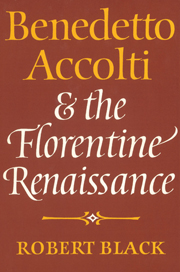Book contents
- Frontmatter
- Contents
- Dedication
- Preface
- Abbreviations
- 1 Arezzo in the early Renaissance
- 2 The Accolti family
- 3 Benedetto Accolti's early life and works
- 4 Accolti in Florence and Arezzo in the 1440s and early 1450s
- 5 Accolti's election as chancellor of Florence
- 6 The Florentine chancellorship
- 7 The Florentine chancery under Accolti
- 8 Accolti's Dialogus
- 9 Accolti's history of the first crusade and the Turkish menace
- 10 Accolti and Renaissance historiography
- Epilogue
- Appendix I Letters of Benedetto Accolti
- Appendix II Accolti's work as a palace official during his chancellorship
- Appendix III Pratica concerned with increasing Accolti's salary as chancellor
- Appendix IV Accolti and the incident of Ponzano, July–August 1463
- Select bibliography
- Index
5 - Accolti's election as chancellor of Florence
Published online by Cambridge University Press: 12 October 2009
- Frontmatter
- Contents
- Dedication
- Preface
- Abbreviations
- 1 Arezzo in the early Renaissance
- 2 The Accolti family
- 3 Benedetto Accolti's early life and works
- 4 Accolti in Florence and Arezzo in the 1440s and early 1450s
- 5 Accolti's election as chancellor of Florence
- 6 The Florentine chancellorship
- 7 The Florentine chancery under Accolti
- 8 Accolti's Dialogus
- 9 Accolti's history of the first crusade and the Turkish menace
- 10 Accolti and Renaissance historiography
- Epilogue
- Appendix I Letters of Benedetto Accolti
- Appendix II Accolti's work as a palace official during his chancellorship
- Appendix III Pratica concerned with increasing Accolti's salary as chancellor
- Appendix IV Accolti and the incident of Ponzano, July–August 1463
- Select bibliography
- Index
Summary
In the 1450s Benedetto Accolti became more closely associated with Florence while loosening his remaining ties with Arezzo. Accolti had been bound to Arezzo and his family there by his father's estate, which had been left undivided to the four surviving brothers, Benedetto, Francesco, Donato and Giovanni. In 1445 the brothers had given a dowry of 450 florins to their sister Tommasa, 200 florins of which consisted of a farm inherited from their father at Milisciano in the cortine of Arezzo and the vineyards at San Giovanni in the Aretine countryside. Otherwise, when the Accolti brothers submitted their report for the Aretine catasto of 1454, they had neither added to nor taken away from their patrimony, which had itself remained almost unchanged since 1427. Maintaining joint ownership of this property, which was all located in Arezzo, the Aretine countryside and the Casentino, was a considerable responsibility for Benedetto Accolti as the eldest surviving son. It would obviously have been less burdensome for him if the estate were divided, which is what the three surviving Accolti brothers – Benedetto, Francesco and Donato – did in 1456, fifteen years after their father's death. Benedetto took all the property at Bagnena, while his brothers retained in common the property at Poggibaldi and Salutio; all three continued to own jointly their house and garden in Arezzo. The terms of the division reflect the differing life styles of the three Accolti brothers in the 1450s: Francesco, the successful itinerant lawyer, still had only Arezzo for his permanent home, and it suited him to share his property there with his brother Donato,
- Type
- Chapter
- Information
- Benedetto Accolti and the Florentine Renaissance , pp. 85 - 114Publisher: Cambridge University PressPrint publication year: 1985



